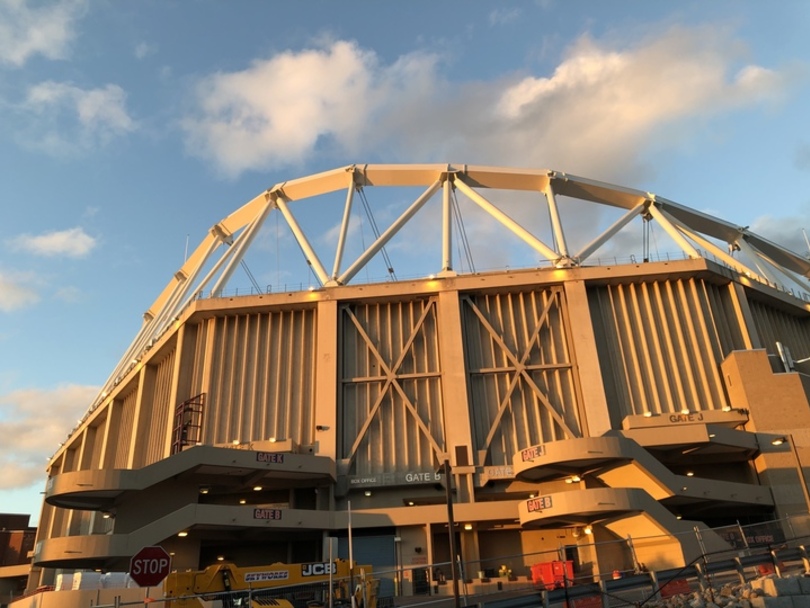SU turns off Dome lights in response to student Earth Day advocacy

The Dome is one of the most prominent sources of nighttime light in the city of Syracuse, Meredith Barges, a PhD student at ESF, said. In response to advocacy efforts on campus, SU will turn off upper ring of lights until Wednesday. Daily Orange File Photo
Get the latest Syracuse news delivered right to your inbox.
Subscribe to our newsletter here.
Syracuse University will turn off the lights of the JMA Wireless Dome’s upper ring until midnight Tuesday as part of a student-led effort to reduce light pollution for Earth Day.
As this year’s Earth Day celebration approached, students at SUNY ESF and Syracuse University saw an opportunity to address light pollution on campus, specifically at the Dome.
A SU spokesperson confirmed the university would turn off the Dome’s upper ring lighting — the section most visible from downtown – from Monday night through midnight Tuesday.
Student advocates said light pollution is a growing concern, not only for environmental reasons, but also for students’ health. The Lights Out Central New York group’s project aims to ultimately shut off non-essential lighting — particularly at night when the Dome is inactive, said Meredith Barges, a PhD student at ESF and co-chair of LOCNY.
In Syracuse, the Dome is one of the most prominent sources of nighttime light, Barges said. Turning off its lights would reduce energy use, lessen ecological harm and align both universities’ practices with their sustainability goals, she said.
“The night sky is getting brighter by 10% every year because of new LEDs,” said Faraz Lotfi, a third-year environmental policy and law major at ESF. “They’re great for cutting costs, but also extremely harmful — not just to animals and birds who are migrating, but people too.”
Nearly 80% of the global population, including over 99% of people in the United States and Europe, live under skies brightened by artificial light, according to NPR. Constant exposure to light can interfere with circadian rhythms, which regulate sleep and mood.
LOCNY organizers partnered with the ESF’s Environmental Health Club to raise awareness about the negative effects of excessive nighttime lighting on student well-being, Lotfi said. The project is supported by ESF’s Environmental Studies Student Organization, Sustainable Energy Club and SU’s Student Government Association, among others.
Light can lead to disruption of the circadian rhythm and has been linked to sleep disorders including insomnia. Barges said academic institutions should implement time-based lighting reductions, like shutting off non-essential lights after midnight. She said this would demonstrate “mindfulness” from SU and present an opportunity for SU and ESF to collaborate.
“A lot of lights are left on when they’re not really needed, or when no one is awake,” Barges said. “If no one’s awake and you know it has some environmental impacts, can some of those lights be safely turned off?”
Light pollution also disrupts natural ecosystems and obscures the night sky. Barges, who studies bird-friendly building policies and has collaborated with campus groups to advocate for practical changes, said excessive lighting can attract large numbers of migrating birds.
Birds are drawn to artificial light from up to 5 km away, and can become entrapped by large buildings and infrastructure in urban areas. Over one billion birds die in the U.S. annually from striking buildings, according to LOCNY.
“We just have to think a little bit more about our lighting choices, because it’s not just humans who are affected by artificial light,” Barges said. “The kind of perspective is to make it more of a conversation about the lighting that we choose.”
Lotfi said the group’s project started last fall after Barges gave a guest lecture on light pollution. Students mobilized to conduct local night audits by surveying areas that produce excess light and drafted a joint letter backed by several environmental student groups to express their concerns.
The project’s initial goal was to convince administrators to turn off the Dome’s lights for a single night, which Lotfi said seemed unlikely at first. He called SU’s agreement to turn off the Dome’s lights a “significant win.”
“We weren’t going to get people to care about birds migrating, or student health or light pollution, if they don’t understand all these things are related,” Lotfi said.
Lotfi and other students are now pushing for more structured environmental policies for the schools, including restricted lighting hours at the Dome. They also hope to update ESF’s Sustainability Action Plan, which remains under review, to formally include a lighting policy.
Student organizers plan to continue their efforts into the fall semester with more nighttime audits and expanded outreach to campus departments. They will host a “Celebrate the Night” event Tuesday evening on the ESF Quad with stargazing and poetry.
“Our next challenge is changing and creating environmentally friendly lighting policy between the campuses,” Lotfi said. “That’s where real sustainability happens.”






